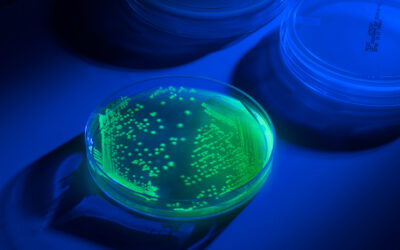 When growing microorganisms, several conditions including incubation time, temperature, pH, adequate moisture and sufficient nutrients (such as carbon and nitrogen) must be considered to ensure successful results.
When growing microorganisms, several conditions including incubation time, temperature, pH, adequate moisture and sufficient nutrients (such as carbon and nitrogen) must be considered to ensure successful results.
Even experienced microbiologists can run into growth issues with finicky microorganisms. With this in mind, we have created a series of blog posts highlighting a variety of tried and true growth methods for creating an environment best suited for reproduction of various microorganism species.
Method for Microaerophiles
Microaerophiles are a group of microorganisms that require a low to reduced oxygen content and an increased carbon dioxide content in the atmosphere for growth. Normal levels of oxygen in the environment are approximately ≈20%1 while typical levels for growth of microaerophiles is around 5-10% oxygen and 8-10% carbon dioxide2. To create this special atmosphere, gas generating systems are utilized to create and monitor the desired levels of oxygen and carbon dioxide. These systems typically include jars or pouches, sachets and an indicator. Below are our recommendations for growth success:
Media: Chocolate agar
Temperature: 35-45°C (42°C for isolation of C.jejuni)
Atmosphere: Microaerophillic (5-10% oxygen and 8-10% carbon dioxide)
Growth Time: 48 to 72 hours
Additional Tips: Use nutritive culture media containing carbon, sulfur, trace elements and complex B vitamins. Supplementation with defibrinated sheep’s blood to the agar plate can also be beneficial along with antibiotics for isolation.
Check out our Growth Requirements for detailed descriptions of all our growth methods.
Common Microaerophiles
One of the most prevalent microaerophiles in the news today is Campylobacter spp. This genus of microorganism is a major cause of foodborne diarrhoeal illness and the leading cause of gastroenteritis in humans worldwide3.
While there are 16 different species of Campylobacter spp., the species most commonly implicated in foodborne illness and gastroenteritis is C.jejuni followed by C.coli. Other strains such as C.lari and C.upsaliensis have also been implicated, but not as frequently.
According to the CDC, “…the Foodborne Diseases Active Surveillance Network (FoodNet) indicates that about 14 cases are diagnosed each year for each 100,000 persons in the population.” The surveillance data is only from reported and diagnosed cases of Campylobacter infection. A more reasonable estimate of the scope of infection is at 1.3 million cases per year to account for those that are not reported or go undiagnosed.
 Campylobacter infections are associated with a variety of foods including unpasteurized dairy products (raw milk), non-chlorinated water, produce and poultry. Raw poultry is the food most commonly associated with C.jejuni infections and outbreaks. In fact, an FDA “survey shows that 20-100% of retail chickens are contaminated.”4
Campylobacter infections are associated with a variety of foods including unpasteurized dairy products (raw milk), non-chlorinated water, produce and poultry. Raw poultry is the food most commonly associated with C.jejuni infections and outbreaks. In fact, an FDA “survey shows that 20-100% of retail chickens are contaminated.”4
Since the infective dose is so small (human feeding studies suggest 400-500 cells4), detection and prevention are key. Consumers can protect themselves from Campylobacter infections by properly cooking chicken, and manufacturers should provide instructions on proper handling of raw poultry on the product label. To help ensure customer safety, food manufacturers also employ many different techniques to detect the presence of the bacteria in food samples.
These procedures include:
- Enrichment broths to increase the population and aid in detection
- Special culture media including nutritive and Isolation agars such as Chocolate and Campy-Cefex
- Biochemical analysis such as triple-sugar iron agar slants, hippurate and ninhydrin, and oxidase
- Microaerophillic atmosphere
Microbiologics manufactures both enumerated and non-enumerated reference strains of C.jejuni and C.lari in our easy to use formats. These products are used in the quality control and validation of food manufactures’ detection methods for Campylobacter. Click here to learn about our products.
- Air Resources Laboratory, NOAA: http://www.arl.noaa.gov/faq_ac14.php
- Microbe Online: http://microbeonline.com/oxygen-requirements-for-pathogenic-bacteria/
- WHO Media Centre, Campylobacter: http://www.who.int/mediacentre/factsheets/fs255/en/
- FDA Bad Bug Book http://www.fda.gov/food/foodborneillnesscontaminants/causesofillnessbadbugbook/ucm070024.htm
- CDC http://www.cdc.gov/foodsafety/diseases/campylobacter/index.html
- FDA BAM: http://www.fda.gov/Food/FoodScienceResearch/LaboratoryMethods/ucm072616.htm
- USDA Microbiology Laboratory Guidebook Method 41.04






I’m curious if you have evaluated the E. cloacae strain ATCC 35030 against the F46 latex agglutination product? The reason I ask is we had a failure on a Campylobacter check sample where we erroneously identified this
organism as Campylobacter. The organism grew up unheeded on Campy Cefex we purchase pre-made, exhibited both the motility and agglutination as we see on positive controls. I appreciate anyone’s comments, suggestions.
No, we have not evaluated E. cloacae (ATCC 35030 / MBL 0388) against the F46 (Microgen) Campylobacter Latex Agglutination test system. Therefore, we cannot comment on why the strain of E. cloacae would produce this false positive reaction. You may want to contact Microgen to inquire about that.
The fact that the strain grew (unheeded) on the Campy Cefex agar (at 42°C) may mean that it has some (atypical) antimicrobial resistance properties, which in turn could be why it was chosen for the ‘check sample’. As you know, Campylobacter is a gram negative (curved) rod or spirochete, and on a wet mount shows tumbling and darting motility. On the other hand, E. cloacae is a gram negative (straight) rod, and on a wet mount shows darting motility. These similar descriptions may be another reason why the strain was chosen for the ‘check sample’. A good way to differentiate the strains is to conduct oxidase testing. Campylobacter is oxidase positive, while E. cloacae is oxidase negative.
Ah, thank you for that tidbit of information. That is not listed anywhere in MLG 41.02 as a criterion for confirming Campylobacter. With their darting motility, I find it no wonder we did not recognize the morphological differences and my tech both remember the latex being a strong reactor. Simple enough to put oxidase strips in as part of the confirmation protocol. Thanks for your help.